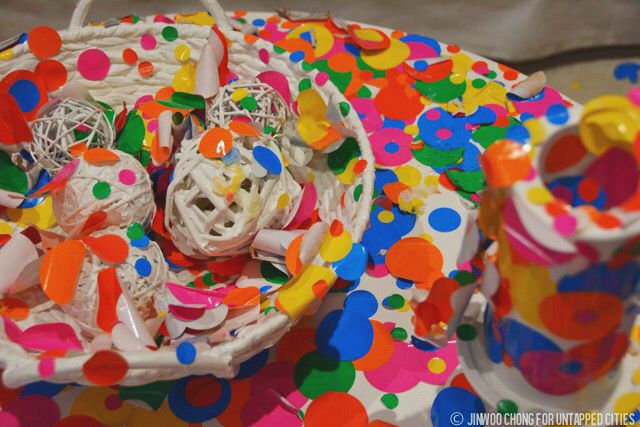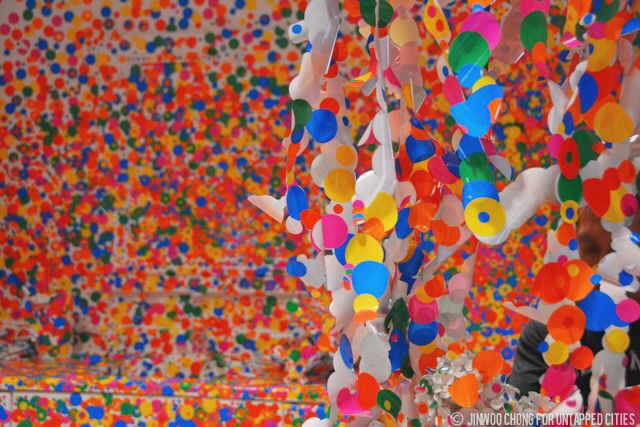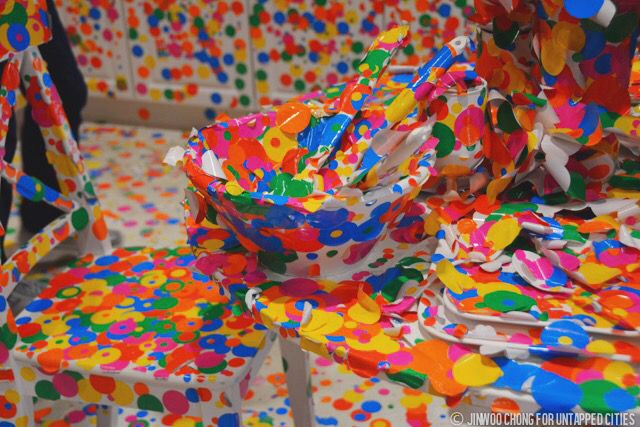Last Chance to Catch NYC's Holiday Notalgia Train
We met the voices of the NYC subway on our nostalgia ride this weekend!


In an age where platforms like Instagram and Twitter can make stars overnight, it’s no surprise that social media is the engine behind Japanese multimedia artist Yayoi Kusama‘s newfound international fame among art lovers as well as the general public. Two years after her last exhibit in the area attracted thousands of viewers and eight-hour lines, Kusama continues her collaboration with David Zwirner Gallery in Chelsea with this year’s latest show, called “Give Me Love.”
Like 2013’s “I Who Have Arrived in Heaven,” “Give Me Love” is split into several portions. The exhibit’s centerpiece called “Obliteration Room,” is what draws the crowds every morning. Originally an all-white pre-fabricated house, complete with white walls and ceilings, white furniture, even white coats hung on hooks near the front door, the piece invites viewers to enter with a sheet full of polka-dot stickers in varying sizes and stick them onto any surface they see fit, provided it remains completely contained within the house. The result is nothing short of breathtaking.

What is perhaps most striking is not the stickers that are most commonly found, plastered in such concentrations on the front walls and the kitchen appliances that the white is no longer seen, but the stickers in the room’s most inaccessible places, behind the couch, on the furthest corner of the ceiling, invisible on the top of the room’s door frame. The exhibit has been open for almost a month, and room, once so pristinely white, is almost completely gone.

Kusama, who completed some of her earliest work in Japan more than 50 years ago, moved to New York City in 1957, where she earned sizable fame among contemporaries like Andy Warhol and George Segal throughout the 1960s. She moved back to Japan in 1973, where a failed art dealing business and deteriorating mental health led to her voluntary admittance to a hospital in 1977. She has lived there ever since, venturing out to her studio only a few minutes away to paint.

As the walls and furniture get increasingly crowded, viewers have resorted to building chains of stickers hanging of the lamps, stovetops, and chandelier.
Thousands of selfies and Instagram posts litter any Google search of Kusama’s exhibits in the last few years. “Give Me Love” is no different. David Zwirner reports that lines form hours before the gallery opens and can reach the lengths of “I Who Have Arrived In Heaven” on the weekends. An effect of her works’ domination of social media, her reach outside the art world and her original followers is what makes her shows phenomenons: colorful, abstract, and striking, her art is designed to portray their immense expanse in a single look or photograph.

Her art has been described as “therapeutic.” In its abstraction, there is an element of physicality to the works, apart from meaning or intent. Dots, stripes, zig-zag lines arranged in bright, simple colors blur together in an inexplicably soothing way. To Kusama, who has stated before that if it weren’t for art, she would have killed herself long ago, her art is more so a form of coping, what she has characterized as a physical manifestation of her delusions, fears, and weaknesses.
Other portions of the show include an open-air installation of man-sized silver sculptures shaped like pumpkins and squash, decorated with bright colored polka-dots and holes and a collection of Kusama’s paintings, neon acrylic paint in exaggerated shapes and forms.

Among the sculptures, like in most Kusama exhibits, photography of any kind is encouraged.
“Give Me Love,” visually stunning because of the direct participation of its viewers, now seems a far more apt title, for the exhibit and the artist alike.
Next, see The Best of the Untapped Cities Photo Pool: Art in NYC Streets and Galleries. Get in touch with the author at @jinwoochong.
Subscribe to our newsletter